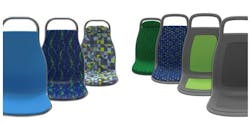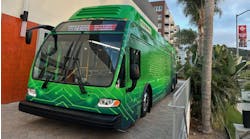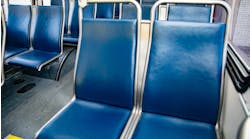Meeting Riders’ Needs for Increased Cleanliness
Issues that negatively impact ridership levels can harm a transit authority’s credibility — even threaten its existence. A leading concern among today’s transit riders is the cleanliness of transit vehicles. People have become increasingly worried about germs that they may come into contact with — even illnesses that they may contract — in a public setting. If a seat looks dirty, many transit riders will choose to stand — or worse, stop riding public transit.
Other than the floor, the dirtiest surface in a transit vehicle is the seating upholstery, which can harbor harmful bacteria. In the worst of cases, there can be social and litigious concerns for riders and transit authorities.
To combat this issue, transit authorities can either move away from upholstered seating or drastically improve their maintenance program.
Over the past several decades, the transit industry has evolved from using heavily cushioned seats to more rigid seating while still maintaining fabric. However, a growing trend among major transit authorities is to specify non-upholstered seating — and this trend is starting to see great success. The perception that only fabric-covered surfaces create a higher level of comfort is fading.
Quite often, the initial impression is that plastic seating surfaces will be less comfortable than fabric, but once a highly ergonomic plastic seat is given a fair try, the desire for fabric is quickly forgotten.
The latest technology to evaluate seat comfort
Field testing through digital ergonomic analysis (also known as pressure mapping) is changing minds and proving that non-upholstered seats are just as comfortable.
Fabric (and foam) add a level of initial warmth to the seating surface, but non-fabric surfaces quickly warm up to body temperature. More important than a thin layer of foam and fabric on a seat is the contour, pitch and back angle of the seat.
While sitting upright on a flat surface, 75 percent of a person’s body weight rests on two concentrated areas — technically referred to as “ischial tuberosities” (known to most of us as the “sit bones”). Cooler colors represent less pressure (absence of discomfort) while warmer colors represent more pressure (discomfort). In this case, the all-plastic InSight seat proves to be more comfortable than another’s fabric-covered seat.
Pressure-mapping technology is commonly used by those specializing in the science of seating, but transit authorities can easily evaluate non-upholstered seats by retrofitting a bus with this option and evaluating rider feedback.
Other options for germ reduction
Other options for germ reduction on seating upholstery include fabric additives, maintenance and alternative materials. New fabric treatments keep fluids from entering the fibers as long as the additive is sufficiently present.
Another method involves cleaning and rotating upholstered components within and between vehicles. However, this practice is only effective with a vigorous, ongoing maintenance program and does not offer real-time effectiveness.
Some transit authorities have moved to vinyl upholstery that is non-permeable by most liquids, but vinyl can easily be cut or damaged and requires ongoing replacement.
Conclusion
Seating is the one component on a vehicle that riders come in contact with more than any other. In the end, it comes down to what best meets the needs of riders and maintenance staff. There are now options, from plush padding to fabric or vinyl only, to all plastic without any upholstery — which are each highly ergonomic and very similar in comfort.
Doug Oswald serves as the marketing director for American Seating and has over two decades’ experience in seating product development. Headquartered in Grand Rapids, Michigan, American Seating employs a U.S.-based workforce and takes pride in sourcing locally. American Seating has been listening to, designing for and investing in public transportation and related industries for 86 years. Flagship products InSight, Vision and Metropolitan were conceived, engineered, tested and tooled by American Seating to meet the needs of the North American heavy-duty transit market.
Doug Oswald | Marketing Director
Doug Oswald serves as the marketing director for American Seating and has over two decades’ experience in seating product development. Headquartered in Grand Rapids, Michigan, American Seating employs a U.S.-based workforce and takes pride in sourcing locally. American Seating has been listening to, designing for and investing in public transportation and related industries for 86 years. Flagship products InSight, Vision and Metropolitan were conceived, engineered, tested and tooled by American Seating to meet the needs of the North American heavy-duty transit market.




